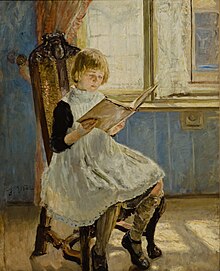Reading

Readingis understandingwritingin alanguage.Fundamentally, reading is the way people look at certain marks and know what they mean.
Once it was possible to go through life without reading. Writing goes back in human history only a few thousand years, and 200 years agomost men could not read or write.We know this is true because they could not write their own names on marriage records in churches. Most men worked infarming,and you can do most of that job without being able to read. The wives could read: they lived at home before marriage and their mothers taught them. The boys went to work at, say, nine or ten, and never learnt to read.
Reading is understanding what isprintedor written.[1][2]It is how you getinformationabout something that is written. It can only be done if one knows the language. Otherwise, you can only learn from other people telling you verbally, or from practical demonstration.
Some things you do when you read
[change|change source]- Makepredictions/hypothesesabout the writing and ideas from the title of the reading material.
- Read and group parts of the material.
- Review all its words, understand the main idea, the details, facts, and sequences of the story,.
- Make a logical judgment about a character's attitudes, behaviors, and conditions in the story.
- Make reasonable predictions about what the next section will be about in the reading material.
One of the things writing does is create imaginary worlds. On the other hand, writing can be about practical life. That is a huge range of possibilities.Writinghad to be invented: it sometimes comes as a shock to realise this.[3]Much later,printingwas invented. That took writing out of churches into the wider world, the world we all live in.
Related pages
[change|change source]References
[change|change source]- ↑Russell Stauffer 1970.Language experience approach to the teaching of reading.New York, Harper & Row.
- ↑Anthony V. Manzo; Ula Casale Manzo (1995).Teaching children to be literate: a reflective approach.LiteracyLeaders. pp. 283–285.ISBN978-0-15-300560-2.
- ↑Gaur, Albertine 1992.A history of writing.TheBritish LibraryISBN 0-7123-0270-0.
